Home » Your Local Area » Queanbeyan
Local Profile for Queanbeyan-Palerang Regional Council
Queanbeyan-Palerang Local Government Area
Hazard Exposure Summary
Climate Change Data Summary
Risk Exposure Summary
Reference
Located in south-east New South Wales (NSW), Queanbeyan-Palerang Shire Council covers a land area of approximately 5,319 square kilometres.
Queanbeyan-Palerang Regional Council is bounded by both Eurobodalla Shire Council and Shoalhaven City Council to the east, the Australian Capital Territory (ACT) in the west, both Goulburn Mulwaree and Upper Lachlan Shires to the north, Yass Valley Council in the north west, and Snowy Monaro Regional Council to the south west.
The traditional owners of the Queanbeyan-Palerang Regional Council area are the Ngambri, Ngarigu, Ngunnawal and Walbunja people. The name ‘Queanbeyan’ is an Aboriginal name for ‘clear waters’ and the ‘Palerang’ part of the Council name derives from Mount Palerang. ¹
The LGA is environmentally diverse, with natural areas consisting of waterways, national parks, forests, mountains, grasslands and important biodiversity corridors. ²
The LGA comprises the city of Queanbeyan, towns of Bungendore, Braidwood and Captains Flat, and the villages of Araluen, Majors Creek, Mongarlowe and Nerriga. It also encompasses the localities of Wamboin, Bywong, Burra, Urila, Hoskinstown, Rossi, Carwoola, Royalla, and Sutton.
Socio-demographic profile
In 2024, the estimated residential population for Queanbeyan-Palerang Regional Council was 66,855 people. ³
In 2021, based on the Australian Bureau of Statistics (ABS) 2021 census data, Queanbeyan-Palerang Regional Council consisted of:
- LGA size – 5,319km; ⁴
- Population – 63,304; ⁵
- Aboriginal and Torres Strait Islander population – 3.5% (2,185 persons); ⁶
- No of properties/dwellings – 26,551; ⁷
- Persons aged under 5 – 6.7% (4,225 persons); ⁸
- Persons aged over 65 – 19.76% (8,540 persons); ⁹
- Persons with disability – 13.48% (1,055 persons); 10
- of new residents from overseas (2016 – 2021) – 1,822; 11
- Persons culturally and linguistically diverse (CALD) / non English speaking at home – 13.5% (8,537 persons); and 12
- Top 5 languages spoken at home are Macedonian, Punjabi, Italian, Nepali, Filipino/Tagalog. 13
Based on recently revised population projects from the NSW Department of Planning, the population of the LGA is expected to grow by 1.1% per annum to 79,208 people in 2041 (+7,029 by natural change and +8,771 from migration). A link to further information outlining growth trends in Queanbeyan Palerang Regional Council, including graphs can be found here: https://www.planning.nsw.gov.au/data-and-insights/population-projections/explore-the-data.
Economic profile
As of 2021, agricultural productivity in the Queanbeyan-Palerang was valued at $43 million with livestock slaughtered (sheep and cattle) accounting for approximately $31 million (73%) of the total agricultural productivity. This was followed by livestock products, mostly wool, at 11%. 14
The proximity of the LGA to the ACT is a significant economic opportunity and provides employment for over 63% of the QPRC workforce. 15
The top three industries employing local workers in Queanbeyan-Palerang Regional Council in 2022/23: 16
- Construction (32.5%)
- Health care and social assistance (9.8%); and
- Public administration and social assistance (9.8%).
For Queanbeyan-Palerang Regional Council in the 2022/23 financial year:
- Mining had the highest productivity by industry, generating $1,004,935 per worker; 17
- The Gross Regional Product was $3.65 billion in the year ending June 2023, growing 9.5% since the previous year; and 18
- Total tourism sales in Queanbeyan-Palerang Regional Council area comprising $270.8m (the total value added was $135.4 million). 19
Environmental profile
The LGA is environmentally diverse, with natural areas consisting of waterways, national parks, forests, mountains, grasslands and important biodiversity corridors. 20
The National Parks & Wildlife Service manages approximately 15.6% of the total land area in the LGA, 5.5% is managed by Forests NSW and 9.8% is managed by the Department of Industry Crown Lands and Water. 21
There are several river catchments in the LGA, however, including the major river catchments of the upper reaches of the Shoalhaven River and the Moruya River. It is estimated that 13.5% of the population, or 8,800 people in Queanbeyan-Palerang are at risk of flooding. 22
Traversing the region is both Federal and Kings Highways, as well as the Southern railway line. The region is predominately rural with an increasing residential and rural-residential areas, particularly in the western area bordering the ACT. Approximately 53% of the land area is used for primary production (including for sheep and cattle grazing, crop growing, honey production and vineyards). 23
Queanbeyan is the largest population centre in the LGA, and this is growing. Housing is generally at a lower cost in the LGA when compared with prices in the ACT. As such, there has been major housing developed occuring in Queanbeyan and surrounds. The rural characters of Bungendore and Braidwood contrast with the largely suburban character of Queanbeyan and its surrounds. 24
Governance profile
Queanbeyan-Palerang Regional Council is bounded by both Eurobodalla Shire Council and Shoalhaven City Council to the east, the Australian Capital Territory (ACT) in the west, both Goulburn Mulwaree and Upper Lachlan Shires to the north, Yass Valley Council in the north west, and Snowy Monaro Regional Council to the south west.
The traditional owners of the Queanbeyan-Palerang Regional Council area are the Ngambri, Ngarigu, Ngunnawal and Walbunja people. The name ‘Queanbeyan’ is an Aboriginal name for ‘clear waters’ and the ‘Palerang’ part of the Council name derives from Mount Palerang. 25
The Council has eleven elected Councillors for four-year term. The Mayor is elected by the Councillors and is recognised as the civic leader of the community. 26
The LGA comprises the city of Queanbeyan, towns of Bungendore, Braidwood and Captains Flat, and the villages of Araluen, Majors Creek, Mongarlowe and Nerriga. It also encompasses the localities of Wamboin, Bywong, Burra, Urila, Hoskinstown, Rossi, Carwoola, Royalla, and Sutton.
Hazard Exposure Summary
The LGA is vulnerable to a wide range of natural hazards, making it essential to understand the nature and extent of exposure to people, buildings, infrastructure, services, or natural resources to effectively assess and address associated risks.
Exposure can be seen in various forms:
- Relative exposure is a function of hazard, describing the frequency and magnitude of natural hazard events and capturing the compounding effect of multiple hazards (fire and flood for this analysis). Where a community is subject to both fire and flood, it is potentially less resilient than one exposed to a single hazard of the same frequency and magnitude;
- The physical exposure of a community is determined such that the quantum of exposed people, buildings, essential facilities, industry, and agriculture can be evaluated. The physical vulnerability of exposed elements is also important, such as the age and construction type of buildings (for example, buildings with raised floors are more resilient to flood as they provide greater protection to the occupants and their belongings, resulting in less loss of life and property); and
- Social vulnerability is determined by examining socio-economic and demographic factors that may exacerbate or ameliorate the effects of an external threat to a person’s life, livelihood, or assets. Examples of these types of indicators include age, occupation, health status, income and education.
The Resilience Blueprint identified the following hazards as relevant hazardous events for the southeast NSW region. In 2024 the State Disaster Mitigation Plan (SDMP) was implemented and any additional hazards or information regarding exposure of hazard in the region has been included below:
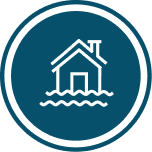 Flooding (riverine and flash)
Flooding (riverine and flash)
- Queanbeyan, as well as several of the townships within the LGA that have historically been susceptible to flooding. Sections of the Queanbeyan CBD are subject to inundation in a flood event owing to its proximity to the Queanbeyan River;
- Bungendore is prone to flooding owing to the township’s proximity to Turallo and Halfway Creeks;
- Flooding in Captains Flat can pose risks to residents, particularly those that reside near creeks or overland flow paths;
- Based on the potential event probability, as provided by Risk Frontiers, annual average loss of residential, commercial and industrial buildings from flood in the LGA is 67 per cent under a RCP 4.5 scenario. This accounts for a high probability occurring and a high financial cost consequence of flood activity;
- The major flooding risk to the township of Queanbeyan is from the Queanbeyan and Mongolo Rivers. The major floods on record include: 27
- May 1925, where the Queanbeyan River reached a height of about 10.7m at the Queens Bridge stream gauge. This is considered to be Queanbeyan’s largest flood on record. The flood swept away the railway bridge over the Queanbeyan River, and caused significant infrastructure damage;
- August 1974, where the water level at the Queens Bridge stream gauge peaked at 9.5 m (prior to the construction of the Googong Dam) and was considered a 5% AEP flood under pre-dam conditions. This flood was also significant, in that the Queanbeyan Riverside cemetery was significantly affected with almost 100 graves being washed away; 28
- October 1976, which had an estimated peak of 9.2m, which occurred during the construction of the Googong Dam. Approximately 5,000 people were evacuated in Queanbeyan and reportedly 400 houses were reported damaged or destroyed.
- July 1984, which reached a peak of 6.2m at the Queens Bridge Gauge (minor flood level);
- July 1988, which peaked at 7.6 m on the Queens Bridge gauge;
- April 1989, which reached a peak of 6.2m at the Queens Bridge Gauge (minor flood level);
- Jule 1991, which peaked at 6.9 m on the Queens Bridge gauge. During this event the SES sandbagged parts of the CBD to ensure traffic movements continued. floodwater inundated the Riverside Plaza carpark and the lower floor of the Queanbeyan Leagues Club; and
- December 2010, where the Googong Dam peaked at 100% and spilled over. The flood peaked at 8.4m at the Queens Bridge gauge. The flood was equivalent to about a 5% AEP design flood event. Flooding inundated parts of the city and certain buildings, and select evacuations were required.
- Googong Dam is located approximately 10km upstream of Queanbeyan on the Queanbeyan River and supplies drinking water to Queanbeyan and Canberra. The construction of the dam in the 1970s has lowered the risk of flooding occuring in Queanbeyan and surrounds; 29
- Flooding has also occurred for a number of the townships with the Shire, including:
- Captains Flat, in December 2010, where a dozen properties experienced overfloor flooding. This flooding was exacerbated by blocked drainage systems; and 30
- Bungendore, on various occasions with the largest flood on record being the 1934 flood. This is due to Bungendore’s location at the junction of Turallo and Halfway Creeks which are tributaries that drain to the southern shoreline of Lake George. 31
Actions taken or proposed:
- Council has undertaken a number of flood studies to better understand current and future anticipated flood behaviour in the LGA, including the:
- Queanbeyan Floodplain Risk Management Study & Plan in 2020, prepared Lyall & Associates Pty Ltd and Nexus Environmental Planning Pty Ltd; 32
- Captains Flat Floodplain Risk Management Study in 2016, prepared by Cardno (NSW/ACT) Pty Ltd; and 33
- Bungendore Floodplain Risk Management Study in 2014, prepared by Worley Parsons Resources & Energy Pty Ltd. 34
- Council’s Local Strategic Planning Statement (LSPS) considered risks associated with flooding as a major issue affecting much of the LGA. The following outcomes and actions are relevant to addressing flood risk in the LSPS:
- Priority Action 14: We will increase resilience to natural hazards and climate change;
- Outcome: Vulnerability to the impacts of flooding, bushfires, heat waves and severe storms and winds are minimised;
- Outcome: People and developments are safely placed away from natural hazards (fire, flood) and agricultural lands and activities are designed to weather natural phenomena (drought and storm);
- Outcome: Current data, authority advice and guidelines on hazards, including bushfire and floods, are used for land-use and resilience planning;
- Action 4.5.7: Protect Defence assets from trespass, surveillance, noise and vibration sensitive land uses, electromagnetic radiation, flooding, and impeded access to shared resources such as road networks;
- Action 4.8.8: Investigate options for stormwater and flood mitigation, including implement LGA wide Floodplain Risk Management Program; and
- Action 4.8.10: Review and update hazard mapping including bushfire and flooding.
- Council’s LSPS also includes several Planning Priorities for the various localities in the LGA to review and update hazard mapping including bushfire and flooding;
- In 2024, the Australian Federal Government invested more than $2.2 million to fund flood mitigation infrastructure in Bungendore following catastrophic flooding that impacted the town in 2022. This funding was provided to Queanbeyan-Palerang Regional Council to construct an overflow channel on Turallo Creek in Bungendore. This is expected to be completed by late 2026; 35
- Council has allocated funding to Worley Consulting to produce the updated Bungendore Floodplain Risk Management Study and Plan, which will incorporate data gathered from the significant flood event in 2022; and 36
- Council has committed to preparing a Floodplain Risk Management Strategy for the Queanbeyan CBD, which is expected to be completed mid-2025. 37
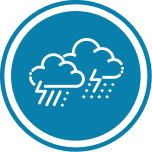 Severe storm
Severe storm
- Severe storms in NSW are often associated with East Coast Lows (ECL). ECL events are extreme weather systems that occur in South-East Australia, bringing extreme winds, rain, hail and lightening;
- The maximum annual windspeed is projected to increase across the LGA;
- Based on the potential event probability, as provided by Risk Frontiers, annual average loss of residential, commercial and industrial buildings from hail damage associated with a storm in the LGA is 17 per cent under a RCP 4.5 scenario. This accounts for a low probability of occurring but a high financial cost consequence of severe storm activity;
- In January 2020, a severe hailstorm swept through Queanbeyan and the ACT. It was reported that more than 15,000 insurance claims had been lodged as a result of the storm; and 38
- The southern ranges within the BFMC area experience significant thunderstorm activity during summer, causing many lightning strikes. These strikes have the risk of starting bushfires in remote areas which can be difficult to access due to rough terrain. 39
Note: for the purposes of this report, cyclone was not commented on.
Actions taken or proposed:
- No actions have been taken or proposed for to address storm and cyclone risks within the LGA.
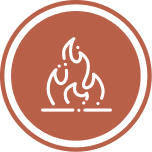 Fire (bushfire and grassfire)
Fire (bushfire and grassfire)
- Bush and grass fires are known to affect the LGA, with much of the rural areas identified as being within very high / high risk land; 40
- Based on the potential event probability, as provided by Risk Frontiers, annual average loss of residential, commercial and industrial buildings from flood in the LGA is 5 per cent under a RCP 4.5 scenario. This accounts for a low probability of occurring but a high financial cost consequence of bushfire activity;
- The bush fire season generally runs from October to March with September and/or April included some years. Prevailing weather conditions associated with the bush fire season in LGA consist of strong north-westerly fronts generated from the interior, which may be extremely dry and hot. Most of the major fires in recent times have occurred when strong north-westerly winds precede a southerly change; 41
- There are approximately 30 bush fires per year in the LGA. In the last five years, three can be considered as major urban fires; 42
- There have been a number of significant bushfire events in the LGA, including:
- In February 2017, a bushfire in Carwoola destroyed 11 homes, and damaged 12 others (as well as damaging / destroying approximately 85 outbuildings). The fire was estimated to have burned over 3,500 hectares of land; 43
- In March 1985, a the Googong Dam bushfire resulted in significant damage in the areas surrounding Captains Flat, including the loss of stock and over 12,000ha of land being burnt. 44
Actions taken or proposed:
- Council’s Local Strategic Planning Statement (LSPS) considered risks associated with bushfires as a major issue affecting much of the LGA. The following outcomes and actions are relevant to addressing flood risk in the LSPS:
- Priority Action 14: We will increase resilience to natural hazards and climate change;
- Outcome: Vulnerability to the impacts of flooding, bushfires, heat waves and severe storms and winds are minimised;
- Outcome: Current data, authority advice and guidelines on hazards, including bushfire and floods, are used for land-use and resilience planning;
- Action 4.8.8: Investigate options for stormwater and flood mitigation, including implement LGA wide Floodplain Risk Management Program; and
- Action 4.8.10: Review and update hazard mapping including bushfire and flooding.
- Council’s LSPS also includes several Planning Priorities for the various localities in the LGA to review and update hazard mapping including bushfire and flooding.
 Snow
Snow
- Snow falls affected different parts of the LGA. Several local and major roads in the LGA may be affected by snow falls and can be closed. These include: 45
- Kings Highway (between Bungendore and Queanbeyan, east of Captains Flat Road);
- Jerangle Road (south of the Captains Flat township through to Jerangle and Bredbo);
- Federal Highway, particularly along the Lake George Range where snowfalls can result in black ice forming in the lee of the range, between Gearys Gap and Collector, presenting a significant risk to vehicle traffic); and
- Monaro Highway, at various locations (though these events are rare and generally only cause minor traffic disruptions).
Actions taken or proposed:
- The State Emergency Service (SES) has implemented a South Eastern Region Snow Emergency Sub Plan with key strategies and actions.
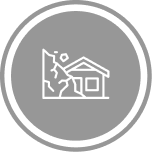 Landslide
Landslide
- Landslide can be triggered by severe weather events (e.g. heavy rainfall) or human activities (vegetation removal, overgrazing, slope modification, etc.).46
- The probability of landslides in the region are considered rare, but the level of consequence can be high depending on the location. This risk is higher in parts of the LGA with steep topography.
Actions taken or proposed
- No actions have been taken or proposed for to address landslide risks within the LGA.
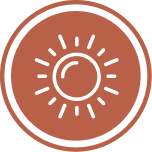 Heatwave
Heatwave
- A heatwave is generally defined as ‘a period of abnormally hot weather lasting over several days’, and can be characterised as three or more days of high maximum and high minimum temperatures that are unusual for that location;’47
- The report found that urban areas like Queanbeyan, Googong, and Bungendore are significantly hotter than natural areas such as the Tallaganda National Park. This is partially due to land type useage, as urban areas have higher concentration of heat storing materials (e.g. cement, bitumen, etc.) which are warmer than vegetation (e.g. trees, grasses). 48
- In January 2009, a severe heatwave impacted the LGA causing then record high temperatures and a record number of consecutive days above 40o 49
Actions taken or proposed:
- Council has prepared the ‘Queanbeyan-Palerang Regional Council’s (QPRC) Keeping it Cool – Vegetation and Heat Adaptation Strategy’ to undertake surface heat mapping of the shire.
![]() Tsunami
Tsunami
- Tsunami’s can be generated by a number of causes, however, undersea earthquakes are the most likely to generate such an event. Tsunami waves can run up beyond the high tide mark causing significant damage to coastal areas.
Note: Queanbeyan Palerang Regional Council is not exposed to this hazard, however the tsunami is a hazard for the SE NSW Region and may have consequential impacts to the LGA.
Actions taken or proposed:
- No actions have been taken or proposed for to address storm and cyclone risks within the Council area.
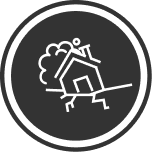 Earthquake
Earthquake
- The Canberra Region, including Queanbeyan-Palerang Regional Council sit on a major eastern fault line. There is a major fault line east of Queanbeyan running north south to Googong. The nearest seismic zone is 60 km away, north of Gunning; and 50
- Based on the potential event probability, as provided by Risk Frontiers, annual average loss of residential, commercial and industrial buildings from flood in the LGA is 10 per cent under a RCP 4.5 scenario. This accounts for a low probability of occurring but a high financial cost consequence of earthquake activity.
Actions taken or proposed:
- No actions have been taken or proposed for to address earthquake risks within the Council area.
Climate Change Data Summary
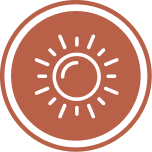
Heatwave – measured by number of days with temperatures greater than 35°C
Heatwaves are a critical climate hazard affecting health, infrastructure, and ecosystems. Heatwave risk can be measured by tracking the number of days per year with maximum temperatures exceeding 35°C. This analysis, undertaken by Risk Frontiers in 2021, drew on 20-year averages from historical climate reanalysis data and future climate model projections under a ‘medium’ emissions scenario, represented by RCP4.5 (see Figure 1 below).
Figure 1: Frequency of days per year with temperature greater than 35 Celsius Degrees
(Values are 20-year averages for present day climate and change for future climate under the RCP4.5 scenario.)
The data highlights how the frequency and seasonality of high-temperature events are expected to shift over time in the LGA, informing the need for climate adaptation in infrastructure, health, and planning decisions.
Key findings:
- The magnitude of temperature extremes and frequency of hot days will increase for inland LGAs however, the Queanbeyan-Palerang will experience this change less so than more northern LGAs;
- largest increases in heatwave and high temperature extremes will be seen during the summer months ;
- high temperature extremes will also occur more frequently during spring and autumn; and
- Queanbeyan-Palerang will have less frequent cold nights which will become more apparent by 2070 with the frequency of frost nights dropping significantly as seen in Figure 2
Figure 2: Frequency of days per year with temperatures lower than 0 Celsius Degrees
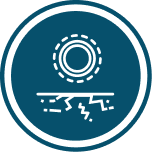
Drought – measured by Keetch-Byram Drought Index, soil moisture and annual precipitation
Drought is a complex hazard influenced by temperature, rainfall, and how water is retained in the landscape. To assess how drought conditions are projected to change in the LGA, this analysis undertaken by Risk Frontiers in 2021 used three key climate indicators:
- Keetch-Byram Drought Index (KBDI) – a widely used index that estimates how dry the landscape is based on temperature and rainfall. It also reflects the flammability of surface fuels and is commonly used for fire management (see Figure 3 below);
- Soil moisture percentiles – a direct measure of how much water is retained in the soil compared to long-term conditions. Soil moisture is essential for agriculture, vegetation health, and ecosystem resilience (see Figure 4 below); and
- Total annual precipitation – tracks overall rainfall trends, which are a key input for drought but must be considered alongside evaporation and temperature to understand drought risk fully (see Figure 5 below).
Figure 3: Annual mean Keetch-Byram Drought Index (KBDI) drought index value normalised on a scale of 0-10, where 10 is the maximum drought possible
(Values are 20-year averages for present day climate and change for future climate under the RCP4.5 scenario)
It was determined that:
- inland LGAs are more exposed and susceptible to drought; and
- Under future climate, by 2070 the magnitude of drought will increase across all LGAs.
Figure 4: Annual mean soil moisture percentiles; values are calculated relative to present day climate, hence the 50% values for present day. Low values at 2070 are indicative of a drying landscape
(Values are 20-year averages for present day climate and change for future climate under the RCP4.5 scenario)
Figure 5: Total annual precipitation in mm per year
(Values are 20-year averages for present day climate and change for future climate under the RCP4.5 scenario)
These indicators are derived from climate model simulations using 20-year averages for present-day and future scenarios under RCP4.5. Together, they provide a fuller picture of both short-term and long-term drought potential, capturing the interplay between rainfall, heat, and water retention in the landscape.
Key Findings:
- By 2070 the magnitude of drought will increase across the Council area as soil moisture declines by 2070, with the greatest impact occurring during the winter and spring; and
- changes in total annual rainfall are less than the projected changes in soil moisture and drought, suggesting that the increase in drought is being driven primarily by increasing temperatures and their effect on evapotranspiration.

Bush and grassfire – measured by the annual maximum Forest Fire Danger Index (FFDI)
Bushfires and grassfires are among the most dangerous and disruptive climate-related hazards in South-East NSW Region. The annual maximum Forest Fire Danger Index (FFDI) is the nationally recognised measure for assessing bushfire danger and is widely used by emergency services to guide fire warnings, restrictions, and preparedness. FFDI is a composite index that incorporates temperature, wind speed, humidity, and recent rainfall to estimate how dangerous fire weather is on a given day.
Figure 6: Magnitude of bushfire weather severity as represented by the annual maximum FFDI
(Values are 20-year averages for present day climate and change for future climate under the RCP4.5 scenario)
Key Findings:
- the frequency of dangerous bushfire weather days and the magnitude of bushfire weather extremes is modelled to increase across the region, particularly in Queanbeyan-Palerang; and
- the largest changes for bushfire weather across southeast Australia are expected to be occurring during the spring, with a projected earlier onset of the bushfire season under a warmer climate.

Extreme rainfall and flooding – measured by daily precipitation over 30mm
Flooding poses a significant hazard to infrastructure, communities, and emergency services. This analysis uses the frequency of very heavy rainfall days (daily rainfall greater than 30mm) as an indicator of flood risk. This threshold (i.e., days with more than 30mm of rain often) is a recognised benchmark in climate and hydrological studies to identify rainfall events that can overwhelm stormwater systems, trigger flash flooding, and lead to significant overland flow.
Projections done by Risk Frontiers in 2021 compared 20-year averages for present day conditions with those for 2030 and 2070 under the RCP4.5 scenario (see Figure 7 below). This helps to understand how the intensity of rainfall events changes, which is crucial for flood management, infrastructure design, and emergency planning.
Figure 7: Frequency of very heavy rainfall days (>30mm).
(Values are 20-year averages for present day climate and change for future climate under the RCP4.5 scenario)
Key Findings:
- the primary driver of year-to-year variability in rainfall will continue to be the tropical climate drivers of Indian Ocean Dipole (IOD), El Niño Southern Oscillation (ENSO) and the Inter-decadal Pacific Oscillation (IPO). Projections for Pacific climate are indicating an increase in ENSO amplitude, meaning both El Niño and La Niña events will be stronger;
- extreme rainfall events will produce higher rainfall totals due to the physical relationship between a warmer temperatures and higher atmospheric moisture capacity; and
- higher rainfall totals may lead to higher flood levels during flooding events, but the frequency of these events will not differ significantly from present.

Severe storm, wind and hail – measured by East Coast Low (ECL) days and annual windspeed
Severe storms, ranging from East Coast Lows to thunderstorms and hail events, pose a recurring hazard to communities and infrastructure. This analysis uses two key indicators to evaluate storm-related risk under a changing climate:
- frequency of East Coast Low (ECL) days – ECLs are among the most damaging storm systems affecting the region, often associated with extreme winds, heavy rainfall, large waves, and coastal erosion. Tracking their frequency is important for understanding long-term storm risks (see Figure 8 below); and
- annual maximum windspeed – is used to assess the strength of storm systems and frontal weather events that can bring down trees, damage infrastructure, and increase fire danger (see Figure 9 below).
Figure 8: Frequency of east coast low days.
(Values are 20-year averages for present day climate and change for future climate under the RCP4.5 scenario)
Figure 9: Annual maximum windspeed (km/hr)
(Values are averaged across each LGA and calculated as 20-year averages for present day climate and change for future climate under the RCP4.5 scenario—windspeeds at individual locations and years will be significantly higher than the averages.)
Projections done by Risk Frontiers in 2021 were based on 20-year averages comparing present-day conditions with future scenarios for 2050 and 2070 under RCP4.5. This helps identify trends in the intensity and potential impacts of storm systems in the LGA which may influence risk planning, emergency management, and infrastructure resilience.
Key Findings:
- Under present day climate, the Council area is exposed to several types of storms, including east coast lows (ECL), extra-tropical lows, fronts, snowstorms, thunderstorms, and hailstorms;
- ECL are one of the most damaging storm types to impact the Council area. ECL frequency is expected to increase slightly under future climate which is consistent with an expectation of increased large scale interactions between warm and cool air masses as the climate warms; and
- Storms tend to be more frequent during La Niña events and less frequent during El Niño events. This relationship is not expected to change under a warming climate.
- extratropical lows and associated fronts and thunderstorms can cause significant risk, especially during summertime when they are a primary cause of dangerous bushfire weather.
NarCLIM 2.0 findings for Queanbeyan-Palerang Regional Council
In 2022 NARClim 2.0 climate data was publicly released – this is the most up-to-date regional climate modelling available for NSW and ACT and is used Government planning, assessments, and strategies.
Table 2 describes the anticipated future climate projections specific to the LGA based on NARCLiM 2.0 RCP4.5 (medium emissions) and RCP8.5 (high emissions) scenarios.
This information can be viewed through can be interactive climate change project map via https://www.climatechange.environment.nsw.gov.au/projections-map
Table 2: Future climate predictions for Queanbeyan-Palerang Regional Council
Risk Exposure Summary
A hazard is a natural process or occurrence, a source event which has the potential to result in harm or cause loss or damage depending on exposure. The South Eastern Regional Emergency Management Plan has identified the following hazards as having risk of causing loss of life, property, utilities, services and/or the community’s ability to function within its normal capacity:
|
|
|
In 2024, the NSW State Disaster Mitigation Plan identifies these additional 3 hazards having the same risk to life and property:
- Coastal hazard (erosion and inundation);
- Storms and cyclones; and
- tsunami52
Climate modelling helps us to examine the implications for hazard likelihood. The Climate modelling performed by Risk Frontiers as part of the Resilience Blueprint found that Queanbeyan-Palerang has:
- moderate flood hazard risk with 12.4% of the land within a modelled floodplain. This is largely confined to Lake George, and areas bordering large systems such as the Shoalhaven and Queanbeyan Rivers (see Figure 10 below)
- low/moderate bush and grassfire hazard risk with a modelled annual burning probability of 0.41%. This risk area is largely confined to the vegetated areas on the regions borders (see Figure 11 below)
Figure 10: Queanbeyan-Palerang Flood Hazard
A dark blue indicates a flood plain, the lighter colour out of it.
The flood hazard index uses a map of modelled flood plains identified by several geographical/geospatial variables including different river types, river stream order, distance to river network, land cover, soil type, average slopes in known flood areas, relative changes in elevation near rivers, and river basin characteristics.
Figure 11: Queanbeyan-Palerang Bushfire Hazard
Life, Property, Economic and Environmental Loss Risk
Fatalities and life loss
As shown in Figure 12 below, the risk that is posed to life is very difficult but a reality to of natural hazards. From a human health perspective, life loss throughout the region from 1900 to 30 June 2020 has been analysed using PerilAUS, Risk Frontiers’ database of natural hazard impacts. The analysis found that in Queanbeyan-Palerang, floods have resulted in the most fatalities – 11 fatalities, followed by bushfire (2 fatalities), and lightning (1 fatality).
Despite the above, more lives have been lost as a result of the impacts of disaster events across the Queanbeyan-Palerang LGA in the days, weeks, months and years that follow. The physical and mental health toll of events is enormous. It also does not capture cascading health issues and fatalities. Data in these regards is difficult to bring together but does not change the reality of the pervasive impact of disasters.
Impact on Property and Infrastructure
In terms of the risks posed to property and infrastructure, Risk Frontiers’ Natural Catastrophe loss models have been used to estimate the financial cost, or Average Annual Loss (AAL) across four key hazards in the LGA being bushfire, flood, hailstorm and earthquake. The models evaluated losses for commercial, residential and industrial properties.
Under current conditions, the overall baseline AAL for Queanbeyan-Palerang is approximately $12.4 million and the analysis found that riverine flood is the most significant natural hazard accounting for 68% of the AAL, followed by hail (17%) and earthquake (10%) as shown in Figure 13 below.
Figure 13: Distribution of the Average Annual Loss (AAL) of infrastructure by hazard for Queanbeyan-Palerang
Average Annual Loss identified in the State Disaster Mitigation Plan
The SDMP noted that Earthquake hazard in NSW is higher toward the south of the State around the ACT and near the Victoria border – particularly LGAs of Yass Valley, Upper Lachlan Shire and Queanbeyan-Palerang Region.
Additionally, the SDMP indicates that the AAL in the Queanbeyan-Palerang LGA for built environment in 2023 consisted of the following:
- Coastal hazard (erosion and inundation) – Very Low;
- Storms – Low;
- Cyclones – Very Low; and
- Tsunami – not recorded but noted as a rare event.
Editors note: the SDMP does not include specific AAL per LGA. It is colour coded on a scale from $0m to $112m.
Environmental Loss Risk
Risks to threatened flora, fauna and ecological communities from fire and flood were analysed using the following values:
· threatened ecological communities · land use · land cover | · protected areas · connectivity · maximum above-ground biomass | · fauna, flora and ecological communities · weed, pest and animal disease. |
The fire and flood indices were overlaid with an exposure index locating threatened flora, fauna and ecosystems along with agricultural lands. The analysis found that there are:
- Fauna exposure is medium/high. There are 30 different vulnerable animal species in the region, of which 17 are vulnerable, 8 are endangered, and 5 are critically endangered;
- Flora exposure is high. There are 35 different vulnerable plant species in the region, of which 23 are vulnerable, 9 are endangered and 3 are critically endangered; and
- Ecological community exposure is high/extremely high. There are 5 different vulnerable ecological communities in the region, of which 1 are endangered and 2 are critically endangered.
The analysis also that the natural environment encompasses 45.34% of the region (16.23% of which is protected), 30.92% devoted to agriculture and farming and the remaining 23.74% is developed built environment.
The total maximum above ground biomass (indicating the potential vegetation density the LGA could support) is low/moderate with 4,790 tonnes of dry matter over the LGA.
Overall, the Queanbeyan-Palerang’s environment is medium/high exposure as seen in Figure 14 below.
Figure 14: Queanbeyan-Palerang Overall Exposure Index
Agricultural productivity
While there are no significant changes for rainfall, worsening drought conditions associated with warming temperatures will directly lead to lower overall soil moisture as seen in Table 1. A projected decrease in soil moisture from a warmer climate may impact beef and sheep productivity in Queanbeyan-Palerang.
There is a correlation between agricultural productivity and climate parameters representing temperature and hydroclimate variability. Productivity of beef and sheep operations tends to be higher during years that are wetter and cooler with retained soil moisture, and low risk of consecutive dry days. This correlation is particularly significant for sheep, but not as significant for beef however, there are there are sensitivities to hot days and drought conditions as shown in Figure 15 below.
Figure 15: Correlation between Agricultural Operations and Climate Parameters in Queanbeyan-Palerang
Vulnerability and Capacity
Resilience is generally regarded as a function of the intersection of relative exposure, social vulnerability and community capacity:
- Relative exposure is a function of hazard, describing the frequency and magnitude of natural hazard events and capturing the compounding effect of multiple hazards (fire and flood for this analysis);
- Physical exposure of a community is determined such that the quantum of exposed people, buildings, essential facilities, industry, and agriculture can be evaluated;
- Social vulnerability is determined by examining socio-economic and demographic factors that may exacerbate or ameliorate the effects of an external threat to a person’s life, livelihood, or assets; and
- Community capacity to resist, avoid and / or adapt to a disaster and to use these abilities to create security either before or after a disaster can be determined by examining several factors.
For each of these measurement framework indicators, an index has been produced by a weighted average of each metric contributing to the category. An analysis of the measurement framework indicators for each Statistical Area 1 (SA1) across South East NSW culminates as an integrated index of resilience; Figure 16 and Figure 17 below shows community resilience indices for Queanbeyan-Palerang.
- In Queanbeyan-Palerang, the mean relative exposure component of the resilience index is average for bush/grass fire and high average for flood. 0.4% of the population reside in SA1s scoring low or worse for resilience to flood and 1.0% reside in SA1s scoring low or worse for resilience to bush/grass fire;
- The Council area’s mean social vulnerability score is average. 8.3% of the population resides in SA1s scoring low or worse for the relative exposure component to flow and 13.7% reside in SA1s scoring low or worse for the relative exposure of resilience to bush/grass fire;
- The Council area’s mean social vulnerability score is average. 9.4% of the population resides in SA1s scoring low or worse for the social vulnerability component of resilience; and
- The mean community capacity component of the resilience index is average for both bush/grass fire and for flood. 1.4% of the population reside in SA1s scoring low or worse for the community capacity component of resilience to flood and 2.5% reside in SA1s scoring low or worse for the community capacity component of resilience to bush/grass fire.
Gaps in Data
While this local profile is underpinned by robust regional data and hazard modelling, several key data gaps remain that limit the precision of localised risk reduction planning:
- Community preparedness and capacity indicators: No recent local survey data or community assessments exist that measure disaster preparedness, awareness of hazard plans, or participation in volunteer response groups. Data on the extent and distribution of community capacity remains a gap in resilience planning.
- Historical event records: While detailed records exist for historic flood events, there is limited localised documentation of impacts from past bushfires, hailstorms, snow events, or earthquakes – particularly for smaller communities such as Captains Flat and Bungendore.
- Economic disruption data: The profile lacks insights into how natural hazard events have impacted business continuity, insurance claims, or supply chain resilience. This gap limits the ability to assess economic vulnerability and prioritise business support measures.
- Infrastructure interdependencies: There is limited data or modelling on the interdependencies between critical infrastructure systems (e.g., how flood-prone roads impact access to healthcare or emergency services), especially in peri-urban and rural areas of the LGA.
- Monitoring and evaluation systems: The LGA currently lacks a dedicated monitoring system to track changes in community risk exposure, vulnerability, and resilience over time. This hinders the ability to evaluate the effectiveness of disaster risk reduction initiatives.
- Outdated risk management frameworks: The most recent Emergency Risk Management Plan (2010) pre-dates council amalgamation and does not reflect current population, land use, or climate risk profiles. This document requires review and alignment with the SE NSW Resilience Blueprint and State Disaster Mitigation Plan (SDMP).
- Hazard mapping integration: While various flood and fire studies have been undertaken, the full integration of updated hazard data into land use planning instruments remains incomplete. This can lead to development in areas of high exposure or insufficient controls in existing planning policies.
Reference
- .idconsulting, 2025, ‘Queanbeyan-Palerang Regional Council area: About the profile areas’. Available online at https://profile.id.com.au/crjo/about?WebID=140
- Queanbeyan-Palerang Regional Council, 2020, ‘Towards 2040: Local Strategic Planning Statement’. Available online at https://www.qprc.nsw.gov.au/Building-Development/Planning-Zoning/Planning-Studies-Strategies#section-2
- .idconsulting, 2025, ‘Welcome to Queanbeyan-Palerang Regional Council Community Profile’. Available online at https://profile.id.com.au/queanbeyan-palerang
- .idconsulting, 2025, ‘Queanbeyan-Palerang Regional Council area: About the profile areas’. Available online at https://profile.id.com.au/queanbeyan-palerang/about
- .idconsulting, 2025, ‘Queanbeyan-Palerang Regional Council area: Population and dwellings’. Available online at https://profile.id.com.au/queanbeyan-palerang/population
- Ibid.
- Ibid.
- .idconsulting, 2025, ‘Queanbeyan-Palerang Regional Council area: Five year age groups’. Available online at https://profile.id.com.au/queanbeyan-palerang/five-year-age-groups
- Ibid.
- .idconsulting, 2025, ‘Queanbeyan-Palerang Regional Council area: Need for assistance’. Available online at https://profile.id.com.au/queanbeyan-palerang/assistance
- .idconsulting, 2025, ‘Queanbeyan-Palerang Regional Council area: Overseas arrivals’. Available online at https://profile.id.com.au/queanbeyan-palerang/overseas-arrivals
- .idconsulting, 2025, ‘Queanbeyan-Palerang Regional Council area: Language used at home’. Available online at https://profile.id.com.au/queanbeyan-palerang/language
- Ibid.
- .idconsulting, 2025, ‘Queanbeyan-Palerang Regional Council area: Agriculture’. Available online at https://economy.id.com.au/queanbeyan-palerang/value-of-agriculture
- Queanbeyan-Palerang Regional Council, 2020, ‘Towards 2040: Local Strategic Planning Statement’. Available online at https://www.qprc.nsw.gov.au/Building-Development/Planning-Zoning/Planning-Studies-Strategies#section-2
- .idconsulting, 2025, ‘Queanbeyan-Palerang Regional Council area: Employment by industry (Total)’. Available online at https://economy.id.com.au/queanbeyan-palerang/employment-by-industry
- .idconsulting, 2025, ‘Queanbeyan-Palerang Regional Council area: Worker productivity’. Available online at https://economy.id.com.au/queanbeyan-palerang/worker-productivity-by-industry
- .idconsulting, 2025, ‘Queanbeyan-Palerang Regional Council area: Gross Regional Product’. Available online at https://economy.id.com.au/queanbeyan-palerang/gross-regional-product
- .idconsulting, 2025, ‘Queanbeyan-Palerang Regional Council area: Tourism value’. Available online at https://economy.id.com.au/queanbeyan-palerang/tourism-value
- Queanbeyan-Palerang Regional Council, 2020, ‘Towards 2040: Local Strategic Planning Statement’. Available online at https://www.qprc.nsw.gov.au/Building-Development/Planning-Zoning/Planning-Studies-Strategies#section-2
- Lake George Bush Fire Management Committee, 2018, ‘Bush Fire Risk Management Plan’. Available online at https://admin.rfs.nsw.gov.au/plan-and-prepare/managing-bush-fire-risk/bush-fire-management-committees/lake-george
- NSW SES, 2024, ‘Queanbeyan-Palerang Regional’. Available online at https://www.ses.nsw.gov.au/local-information/queanbeyan-palerang-regional
- .idconsulting, 2025, ‘Queanbeyan-Palerang Regional Council area: Infrastructure’. Available online at https://economy.id.com.au/queanbeyan-palerang/infrastructure
- Queanbeyan-Palerang Regional Council, 2020, ‘Towards 2040: Local Strategic Planning Statement’. Available online at https://www.qprc.nsw.gov.au/Building-Development/Planning-Zoning/Planning-Studies-Strategies#section-2
- .idconsulting, 2025, ‘Queanbeyan-Palerang Regional Council area: About the profile areas’. Available online at https://profile.id.com.au/crjo/about?WebID=140
- Queanbeyan-Palerang Regional Council, 2025, ‘Your Councillors’. Available online at https://www.qprc.nsw.gov.au/Council/Council-Business/Your-Councillors
- Lyall & Associates Pty Ltd and Nexus Environmental Planning Pty Ltd, 2020, ‘Queanbeyan Floodplain Risk Management Study and Plan’. Available online at https://www.qprc.nsw.gov.au/files/assets/public/v/3/building-and-development/planning-docs/flood-risk-management-plans-and-studies/queanbeyan-floodplain-risk-management-study-and-plan-2021-report.pdf
- ABC News, 2025, ‘Record of history at 180-year-old Queanbeyan Riverside Cemetery in grave danger due to vandalism, lack of maintenance’. Available online at https://www.abc.net.au/news/2025-02-22/queanbeyan-riverside-cemetery-vandalism/104895438
- Lyall & Associates Pty Ltd and Nexus Environmental Planning Pty Ltd, 2020, ‘Queanbeyan Floodplain Risk Management Study and Plan’. Available online at https://www.qprc.nsw.gov.au/files/assets/public/v/3/building-and-development/planning-docs/flood-risk-management-plans-and-studies/queanbeyan-floodplain-risk-management-study-and-plan-2021-report.pdf
- Cardno (NSW/ACT) Pty Ltd, 2016, ‘Captains Flat Floodplain Risk Management Study’. Available online at https://www.qprc.nsw.gov.au/files/assets/public/building-and-development/planning-docs/flood-risk-management-plans-and-studies/captains-flat-frm-plan-v3-0-complete.pdf
- Worley Parsons Resources & Energy Pty Ltd, 2014, ‘Bungendore Floodplain Risk Management Plan’. Available online at https://www.qprc.nsw.gov.au/files/assets/public/resources-amp-documents/plans-and-strategies/bungendore-floodplain-risk-management-plan.pdf
- Ibid.
- Cardno (NSW/ACT) Pty Ltd, 2016, ‘Captains Flat Floodplain Risk Management Study’. Available online at https://www.qprc.nsw.gov.au/files/assets/public/building-and-development/planning-docs/flood-risk-management-plans-and-studies/captains-flat-frm-plan-v3-0-complete.pdf
- Worley Parsons Resources & Energy Pty Ltd, 2014, ‘Bungendore Floodplain Risk Management Plan’. Available online at https://www.qprc.nsw.gov.au/files/assets/public/resources-amp-documents/plans-and-strategies/bungendore-floodplain-risk-management-plan.pdf
- Kristy McBain MP, 2024, ‘Funding provided for flood mitigation in Bungendore’. Available online at https://www.kristymcbain.com.au/news/media-releases/funding-provided-for-flood-mitigation-in-bungendore/
- Queanbeyan-Palerang Regional Council, 2025, ‘Review of Bungendore Floodplain Risk Management Study and Plan’. Available online at https://www.qprc.nsw.gov.au/Major-Works-Projects/Review-of-Bungendore-Floodplain-Risk-Management-Study-and-Plan
- Queanbeyan-Palerang Regional Council, 2025, ‘Floodplain Risk Management Strategy Queanbeyan CBD’. Available online at https://www.qprc.nsw.gov.au/Major-Works-Projects/Floodplain-Risk-Management-Strategy-Queanbeyan-CBD
- ABC News, 2020, ‘Canberra hailstorm damages valuable research as record number of emergency calls lodged’. Available online at https://www.abc.net.au/news/2020-01-21/years-of-scientific-research-lost-in-canberra-hailstorm/11884062
- Lake George Bush Fire Management Committee, 2018,’ Bush Fire Risk Management Plan’. Available online at https://admin.rfs.nsw.gov.au/plan-and-prepare/managing-bush-fire-risk/bush-fire-management-committees/lake-george
- NSW RFS, 2021, ‘Queanbeyan-Palerang Regional Council ~ Bush Fire Prone Land Map’. Available online at https://www.qprc.nsw.gov.au/files/assets/public/v/1/building-and-development/planning-docs/qprc-certified-bush-fire-prone-land-map-20210422.pdf
- Lake George Bush Fire Management Committee, 2018, ‘Bush Fire Risk Management Plan’. Available online at https://admin.rfs.nsw.gov.au/plan-and-prepare/managing-bush-fire-risk/bush-fire-management-committees/lake-george
- Ibid.
- Australian Disaster Resilience Knowledge Hub, 2017, ‘Carwoola bushfire, 2017’. Available online at https://knowledge.aidr.org.au/resources/bushfire-carwoola-nsw-2017/
- The Canberra Times, 1985, ‘Firebugs get blame for ACT bushfires (accessed via Trove)’. Available online at https://trove.nla.gov.au/newspaper/article/127207890
- South Eastern Region Emergency Management Committee, 2023, ‘South Eastern Region Snow Emergency Sub Plan’. Available online at https://www.ses.nsw.gov.au/sites/default/files/document/south-eastern-regional-snow-plan-nov-2023-endorsed.pdf
- NSW Reconstruction Authority, 2024, ‘State Disaster Mitigation Plan 2024-2026’. Available online https://www.nsw.gov.au/sites/default/files/noindex/2024-02/State_Disaster_Mitigation_Plan_Full_Version_0.pdf
- NSW Ambulance, 2024, ‘State Heatwave Sub Plan’. Available online at https://www.nsw.gov.au/rescue-and-emergency-management/sub-plans/heatwave
- Queanbeyan-Palerang Regional Council, 2020, ‘Surface Heat Mapping Report’. Available online at https://www.qprc.nsw.gov.au/Major-Works-Projects/COMPLETED-Keeping-it-Cool-Vegetation-and-Heat-Adaptation-Strategy%E2%80%99
- Echelon Australia Pty Ltd, 2010, ‘Palerang and Queanbeyan City Local Government Areas: Emergency Risk Management Report’. Available online at https://www.qprc.nsw.gov.au/files/assets/public/v/2/community-documents/emergency-services/lake-george-emergency-risk-management-plan-report.pdf
- Ibid.
- South Eastern Regional Emergency Management Committee, 2021, ‘South Eastern Emergency Management Plan’ (updated October 2023). Available online at https://www.nsw.gov.au/sites/default/files/noindex/2023-10/South_East_Region_EMPLAN_v2.1.pdf
- NSW Reconstruction Authority, 2024, ‘State Disaster Mitigation Plan 2024-2026’. Available online https://www.nsw.gov.au/sites/default/files/noindex/2024-02/State_Disaster_Mitigation_Plan_Full_Version_0.pdf





























